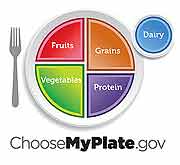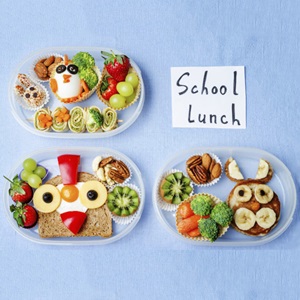Healthy Eating During Adolescence
What is healthy eating?
Eating healthy is an important part of a healthy lifestyle and is something that should be taught at a young age. The following are some general guidelines for helping your adolescent eat healthy. It is important to discuss your adolescent's diet with his or her health care provider before making any dietary changes or placing your adolescent on a diet. Discuss the following healthy eating recommendations with your adolescent to ensure he or she is following a healthy eating plan:
-
Eat 3 meals a day, with healthy snacks.
-
Increase fiber in the diet and decrease the use of salt.
-
Drink water. Try to avoid drinks that are high in sugar. Fruit juice can have a lot of calories, so limit your adolescent's intake. Whole fruit is always a better choice.
-
Eat balanced meals.
-
When cooking for your adolescent, try to bake or broil instead of fry.
-
Make sure your adolescent watches (and decreases, if necessary) his or her sugar intake.
-
Eat fruit or vegetables for a snack.
-
Decrease the use of butter and heavy gravies.
-
Eat more chicken and fish. Limit red meat intake, and choose lean cuts when possible.

Making healthy food choices
The MyPlate icon is a guideline to help you and your adolescent eat a healthy diet. MyPlate can help you and your adolescent eat a variety of foods while encouraging the right amount of calories and fat.
The USDA and the U.S. Department of Health and Human Services have prepared the following food plate to guide parents in selecting foods for children age 2 and older.
The MyPlate icon is divided into 5 food group categories, emphasizing the nutritional intake of the following:
-
Grains. Foods that are made from wheat, rice, oats, cornmeal, barley, or another cereal grain are grain products. Examples include whole wheat, brown rice, and oatmeal.
-
Vegetables. Vary your vegetables. Choose a variety of vegetables, including dark green, red, and orange vegetables, legumes (peas and beans), and starchy vegetables.
-
Fruits. Any fruit or 100% fruit juice counts as part of the fruit group. Fruits may be fresh, canned, frozen, or dried, and may be whole, cut up, or pureed.
-
Dairy. Milk products and many foods made from milk are considered part of this food group. Focus on fat-free or low-fat products, as well as those that are high in calcium.
-
Protein. Go lean on protein. Choose low-fat or lean meats and poultry. Vary your protein routine—choose more fish, nuts, seeds, peas, and beans.
Oils are not a food group, yet some, such as nut oils, contain essential nutrients and can be included in the diet. Others, such as animal fats, are solid and should be avoided.
Exercise and everyday physical activity should also be included with a healthy dietary plan.
Nutrition and activity tips
-
Try to control when and where your child eats by providing regular daily meal times with social interaction and demonstration of healthy eating behaviors.
-
Involve children in the selection and preparation of foods and teach them to make healthy choices by providing opportunities to select foods based on their nutritional value.
-
For children in general who eat a typical American diet, reported dietary intakes of the following are low enough to be of concern by the USDA: calcium, magnesium, potassium, and fiber. Select foods with these nutrients when possible.
-
Most Americans need to reduce the amount of calories they consume. When it comes to weight control, calories do count. Controlling portion sizes and eating nonprocessed foods helps limit calorie intake and increase nutrients.
-
Parents are encouraged to provide recommended serving sizes for children.
-
Parents are encouraged to limit children’s video, television watching, and computer use to less than 2 hours daily and replace the sedentary activities with activities that require more movement.
-
Children and adolescents need at least 60 minutes of moderate to vigorous physical activity on most days for maintenance of good health and fitness and for healthy weight during growth.
-
To prevent dehydration, encourage children to drink fluid regularly during physical activity and drink several glasses of water or other fluid after the physical activity is completed.
To find more information about the Dietary Guidelines for Americans, 2015–2020 and to determine the appropriate dietary recommendations for your child’s age, sex, and physical activity level, visit the Online Resources page for the links to ChooseMyPlate and 2015–2020 Dietary Guidelines sites. Please note that the MyPlate plan is designed for people older than age 2 who do not have chronic health conditions.
Always talk with your adolescent's health care provider regarding his or her healthy diet and exercise requirements.

7 School Lunch Tips for Picky Eaters
Getting your child to eat healthfully is a struggle for many parents, especially if you have a picky eater in your family. Picky eaters often bring back unopened lunch boxes or ignore the healthy foods you’ve packed and go straight for the dessert. Learn helpful tips and tricks for outsmarting your picky eater from a Johns Hopkins pediatric dietitian.
Healthy eating during adolescence
Healthy eating during adolescence is important as body changes during this time affect an individual's nutritional and dietary needs. Adolescents are becoming more independent and making many food decisions on their own. Many adolescents experience a growth spurt and an increase in appetite and need healthy foods to meet their growth needs. Adolescents tend to eat more meals away from home than younger children. They are also heavily influenced by their peers. Meal convenience is important to many adolescents and they may be eating too much of the wrong types of food, like soft drinks, fast-food, or processed foods.
Also, a common concern of many adolescents is dieting. Girls may feel pressure from peers to be thin and to limit what they eat. Both boys and girls may diet to "make weight" for a particular sporting or social event.
The following are some helpful considerations as you prepare meals for your adolescent:
-
Arrange for teens to find out about nutrition for themselves by providing teen-oriented magazines or books with food articles and by encouraging them and supporting their interest in health, cooking, or nutrition.
-
Take their suggestions, when possible, regarding foods to prepare at home.
-
Experiment with foods outside your own culture.
-
Have several nutritious snack foods readily available. Often, teenagers will eat whatever is convenient.
-
If there are foods that you do not want your teens to eat, avoid bringing them into the home.





